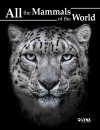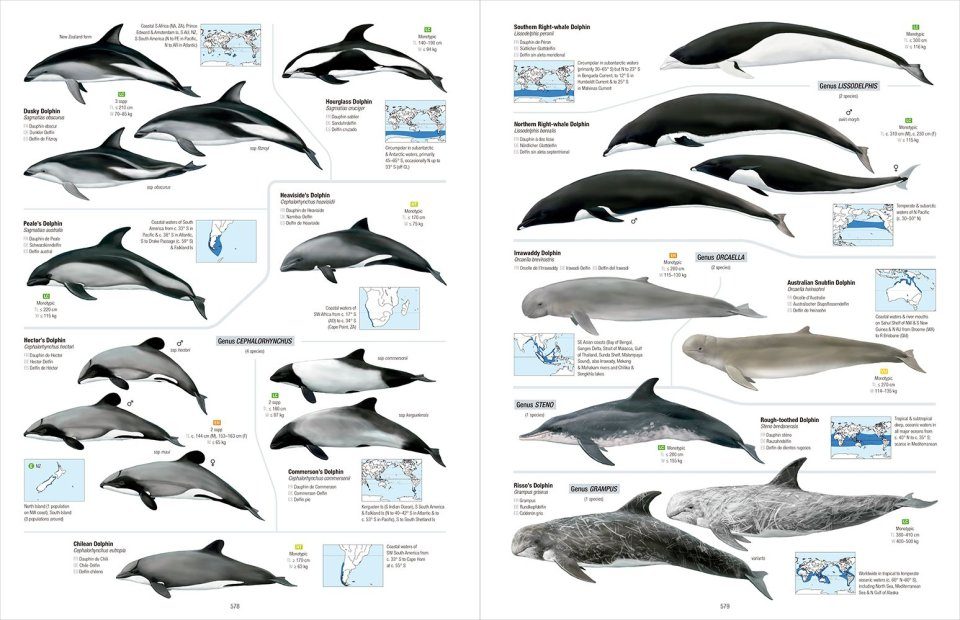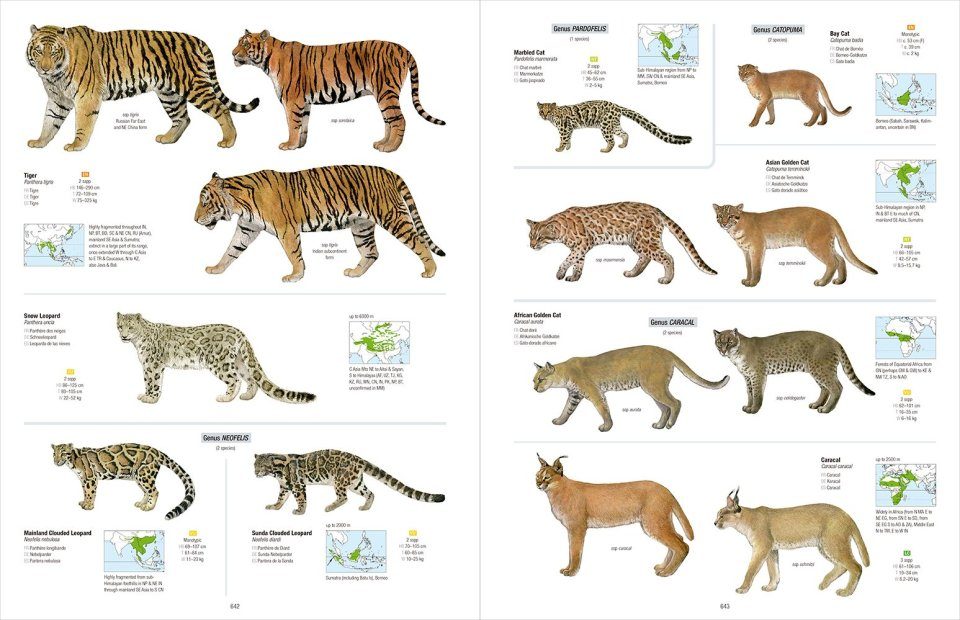


1) Monadjem, Ara (Foreword). All the Mammals of the World. 2023. Lynx Nature Books. Hardbound: 799 pages. Price: 89.00 Euros (about $99.05 U.S.).
For the first time ever, you can contemplate all the mammals of the
World together in a single easy-to-use, fully illustrated volume.
Created for a broad public, from wildlife enthusiasts to expert
mammalogists, researchers, conservationists, and anyone interested in
the spectacular diversity of mammals, this book has something for
everyone.
- Presents 6581 species in total, including 6459 extant wild species, 19 domestic species and 103 extinct species.
- 7349 illustrations covering all species as well as sexual dimorphism, morphs and some distinctive subspecies.
- Relevant measurements for length and mass provided when available, as well additional data for groups where important.
- 6459 distribution maps, with written summary and notes on altitudinal ranges.
- All 2834 one-country endemic species marked.
- Species common names provided in English, French, German and Spanish, as well as scientific names.
- The IUCN Red List category of extinction risk is given for each species to highlight the importance of study and conservation.
- Taxonomic summary of the number of subspecies for each taxon.
-
Appendix listing all taxonomic changes from the Illustrated Checklist
of the Mammals of the World to the present, including 107 newly
described species and 106 split species, and explaining the most
important cases.
- More than 100 species known to have become extinct since the year 1500 are presented separately in their own appendix.
- Summary of recognized domestic species is provided in a separate appendix.
- A 37-page world atlas of colour reference maps, with relevant details of interest to mammal enthusiasts and professionals.
- The easiest and most enjoyable way to browse through all the mammals of the world.
All the Mammals of the World
has two clear antecedents, with which it shares many of its goals,
especially that of spreading and promoting interest in mammals and
wildlife worldwide: the Handbook of the Mammals of the World series in 9 volumes, the first printed work to include all the mammals of the world; and the Illustrated Checklist of the Mammals of the World in two volumes, which provides a taxonomic review of the previous publication. All the Mammals of the World in a single volume aims to bring the extraordinary richness and diversity of the world’s mammals closer to a wider audience.
RECOMMENDATION: This book is a MUST have for anyone with an interest in mammals! This title is a companion to All
the Birds of the World but that title includes taxonomic details (not useful in
mammals where 1 source is basically followed) and QR codes to eBird
(unfortunately there is no online resource this vast for mammals yet!),
while All the Mammals of the World takes advantage of that space for
names in French, German and Spanish and more detailed measurements.This book can be ordered here.

2) Svensson, Lars. Princeton University Press. Paperback: 476 pages. Price: $
An
expanded, comprehensively revised, and completely up-to-date new
edition of the leading illustrated field guide to Europe’s birds.
Since it was first published, Birds of Europe
has established itself as the definitive illustrated field guide to the
continent’s fascinating birdlife. Now in its third edition, this superb
guide has been expanded and brought completely up to date with revised
text, illustrations, and maps.
More than 50 plates are either new
or have been completely or partly repainted, and more pages,
illustrations, and text have been added for several bird groups,
including grouse, loons, raptors, terns, owls, swifts, woodpeckers,
swallows, redstarts, tits, finches, and buntings. Newly discovered
species are included, species that have expanded their range are now
found in the main text, and species that have only recently been seen
more than five times are gathered in an accidentals section.
Combining unmatched illustrations, text, and maps in a single, portable, and easy-to-use volume, Birds of Europe is the ultimate field guide to the continent’s birdlife―essential for every birdwatching trip and bookshelf.
- Provides all the information needed to identify any species at any time of the year
- Detailed text covers size, habitat, range, identification, and voice
- Comprehensively illustrated with the best field guide artwork ever painted
- Up-to-date distribution maps with information on breeding, wintering, and migrations
- Covers all the species that are new to the continent or have been newly discovered
- Features text and illustrations on facing pages for easy use in the field
- Includes an introduction to each bird group that addresses major problems of observation and identification
RECOMMENDATION: This book is a MUST have for anyone birding Europe!
3) Serjeantson, Dale. Oxbow Books. Hardbound: 238 pages. Price: $95.00 U.S.
The Archaeology of Wild Birds in Britain and Ireland
tells the story of human engagement with birds from the end of the last
Ice Age to about AD 1650. It is based on archaeological bird remains
integrated with ethnography and the history of birds and avian biology.
In addition to their food value, the book examines birds in ritual
activities and their capture and role in falconry and as companion
animals. It is an essential guide for archaeologists and
zooarchaeologists and will interest historians and naturalists concerned
with the history and former distribution of birds. RECOMMENDATION: This book is a must read for anyone with an interest in the ornithological history of Britain and Ireland.
4) Yoxon, Paul & Grace M.. 2015. Whittles Publishing. Paperback: 154 pages. Price: $24.95 U.S.
This is an introduction to the magical world of otters with many wonderful photos and distribution maps for each species.
The
Asian small-clawed otters, often found in zoos, or the sea otter,
well-known for lying on its back cracking open shells, may be familiar
to many but there are many more fascinating species. Having worked for
over 20 years on otter conservation the authors want to share their
enthusiasm and passion for these animals.
Each species is listed
in the IUCN Red Data List and yet little attention is given to their
predicament. The illegal wildlife trade in otters is huge—not just for
furs and body parts but as pets. In some parts of the world otters are
disappearing rapidly and unless urgent action is taken they will be gone
forever. It is hoped the book will increase awareness and support for
the work of the IOSF (International Otter Survival Fund) which is
battling the threat of extinction to several species.
Otters stand at
the top of the food chain on both land and water so they are an ideal
indicator of a healthy environment. With greater awareness and support
the IOSF will be able to do more on the world stage to conserve otters
as exemplified by the Hairy-Nosed Otter which was rediscovered and
helped having been thought extinct. This type of conservation work is
vital because so often the plight of otters is overlooked for other high
profile species such as tigers and elephants.
Proceeds from the sale of this book will go to the IOSF.
RECOMMENDATION: This book is a readable overview of the World's otters.
5) Dickie, Gloria. W. W. Norton. Hardbound: 272 pages. Price: $
A global exploration of the eight remaining species of bears―and the dangers they face. Bears
have always held a central place in our collective memory, from
Indigenous folklore and Greek mythology to nineteenth-century fairytales
and the modern toy shop. But as humans and bears come into ever-closer
contact, our relationship nears a tipping point. Today, most of the
eight remaining bear species are threatened with extinction. Some, such
as the panda bear and the polar bear, are icons of the natural world;
others, such as the spectacled bear and the sloth bear, are far less
known.
In Eight Bears,
journalist Gloria Dickie embarks on a globe-trotting journey to explore
each bear’s story, whisking readers from the cloud forests of the Andes
to the ice floes of the Arctic; from the jungles of India to the
backwoods of the Rocky Mountain West. She meets with key figures on the
frontlines of modern conservation efforts―the head of a rescue center
for sun and moon bears freed from bile farms, a biologist known as Papa
Panda, who has led China’s panda-breeding efforts for almost four
decades, a conservationist retraining a military radar system to detect
and track polar bears near towns―to reveal the unparalleled challenges
bears face as they contend with a rapidly changing climate and
encroaching human populations.
Weaving together
ecology, history, mythology, and a captivating account of her travels
and observations, Dickie offers a closer look at our volatile
relationship with these magnificent mammals. Engrossing and deeply
reported, Eight Bears
delivers a clear warning for what we risk losing if we don’t learn to
live alongside the animals that have shaped our cultures, geographies,
and stories.
RECOMMENDATION: This book is a must read for anyone with an interest in bears.

6) Iselin, Josie.
In
this captivating book, artist and avid beachcomber Josie Iselin reveals
the unexpected beauty of seaweed. Produced on a flatbed scanner,
Iselin’s vibrant portraits of ocean flora reveal the exquisite color and
extraordinary forms of more than two hundred specimens gathered from
tidal pools along the California and Maine coasts. Her engaging text,
which accompanies the images, blends personal observation and
philosophical musings with scientific fact. Now available in paperback
for the first time, this edition includes a new foreword and updated
nomenclature. An Ocean Garden is a poetic and compelling tribute to the natural world and the wonder it evokes.
RECOMMENDATION: The artwork in this book is worth the price of the book alone!

7) Brenner, Kelly. Mountaineers Books. Paperback: 221 pages. Price: $
The Naturalist at Home
emphasizes hands-on exploration with easy outdoor projects designed to
help naturalists observe and study everything from invertebrates to
mushrooms to mammals. Critically-acclaimed writer and naturalist Kelly
Brenner developed these projects based on real techniques used by
naturalists and scientists in the field. Easy to adapt, they are
suitable for naturalists at all levels of experience and expertise.
These projects bridge the gap between sophisticated science experiments
and easy nature activities and between reading about nature and
experiencing it in a real and tangible way. They are simple to carry
out, and naturalists can repurpose items they have at home, find them at
a thrift store, or purchase inexpensive tools and materials. Detailed
descriptions of organisms, along with the author’s hand-drawn
illustrations, help naturalists visualize what they may discover.
- Features 20 projects with clear descriptions of materials and tools, plus a few bonus activities
- Includes step-by-step instructions with charming, informative illustrations
- Tips for troubleshooting and taking the project to the next level
RECOMMENDATION: I think children will like these projects!

8) Broberg, Gunnar. Princeton University Press. Hardbound: 484 pages. Price:
Carl Linnaeus (1707–1778), known as the father of modern
biological taxonomy, formalized and popularized the system of binomial
nomenclature used to classify plants and animals. Linnaeus himself
classified thousands of species; the simple and immediately recognizable
abbreviation “L” is used to mark classifications originally made by
Linnaeus. This biography, by the leading authority on Linnaeus, offers a
vivid portrait of Linnaeus’s life and work. Drawing on a wide range of
previously unpublished sources―including diaries and personal
correspondence―as well as new research, it presents revealing and
original accounts of his family life, the political context in which he
pursued his work, and his eccentric views on sexuality.
The Man Who Organized Nature
describes Linnaeus’s childhood in a landscape of striking natural
beauty and how this influenced his later work. Linnaeus’s Lutheran
pastor father, knowledgeable about plants and an enthusiastic gardener,
helped foster an early interest in botany. The book examines the
political connections that helped Linnaeus secure patronage for his
work, and untangles his ideas about sexuality. These were not, as often
assumed, an attempt to naturalize gender categories but more likely
reflected the laissez-faire attitudes of the era. Linnaeus, like many
other brilliant scientists, could be moody and egotistical; the book
describes his human failings as well as his medical and scientific
achievements. Written in an engaging and accessible style, The Man Who Organized Nature―one
of the only biographies of Linnaeus to appear in English―provides new
and fascinating insights into the life of one of history’s most
consequential and enigmatic scientists.
RECOMMENDATION: This book is a must read for anyone with an interest in Carl Linnaeus.

9) McCarthy, James. Whittles Publishing. Paperback: 223 pages. Price: $29.95 U.S.
Archibald Menzies was one of a legion of intrepid Scots plant
collectors in the 18th and 19th centuries who roamed the world and, by a
combination of toughness and knowledge, established the foundations of
the botany of the British Empire. This is a fascinating tale of how he
brought the monkey puzzle to England for the first time and provides an
insight to international plant collecting in the 18th century.
Based
on his diaries, the author recounts how Menzies, whilst on a classic
voyage of exploration in which he circumnavigated the world twice, is
the only naval surgeon to be placed under arrest for insubordination -
and all because his precious plants were washed away! He is also the
only man to have pocketed his dessert at a foreign presidential banquet,
which subsequently resulted in the introduction of one of the most
curious trees to Britain's parks and estates.
The author
tells a tale of high adventure on land and sea in the latter part of the
18th century, from a surgeon's grisly work at the Battle of the Saints
in the West Indies to the seductive allure of Tahitian maidens and plant
collecting in freezing Alaska. Menzies was the first to ascend the
fiery volcano of Mauna Loa in Hawaii, where the natives aptly described
him as 'the red-faced man who gathered grass and cut off men's limbs'.
An acclaimed naturalist, Menzies made major botanical discoveries during
the epic journey of HMS Discovery under Captain George Vancouver along
the north-west coast of America in the early 1790s, discovering many
plants which now adorn British and continental gardens. He also
described the California Condor and made important early
anthropological observations on the native peoples of North America.
In
this highly readable book, the author recounts the story of how a young
Scots gardener from humble origins became a distinguished plant pioneer
who changed the face of gardens throughout Europe by his botanical
discoveries.
RECOMMENDATION: This book is a must read for anyone with an interest in botanical history.

10) Wheeler, Quentin. Routledge. Paperback: 246 pages. Price:
This
book presents an engaging and accessible examination of the role of
systematic biology in species exploration and biodiversity conservation.
Our
planet and systematic biology are at a crossroads. Millions of species
face an imminent threat of extinction, and, with knowledge of only a
fraction of earth’s species we are unprepared to respond. Species, Science and Society
explains what is at stake if we continue to ignore the traditional
mission of systematics. Rejecting claims that it is too late to document
earth’s species, that molecular evidence is sufficient and that
comparative morphology and the grand traditions of systematics are
outdated, this book makes a compelling argument for a taxonomic
renaissance. The book challenges readers to rethink assumptions about
systematics. Shattering myths and misconceptions and clarifying the role
of systematics in confronting mass extinction, it hopes to inspire a
new generation of systematists. Readers are given a deeply personal view
of the mission, motivations and rewards of systematic biology. Written
in narrative style with passion, wit and optimism, it is the first book
to question the growing dominance of molecular data, defend descriptive
taxonomy and propose a mission to discover, describe and classify all
species. Our evolutionary heritage, the fate of society and the future
of the planet depend on what we do next.
This book
will be of great interest to academics, researchers and professionals
working in systematics, taxonomy and biodiversity conservation, as well
as students with a basic background in biology.
RECOMMENDATION: This book is a must read for anyone with a serious interest in systematic biology.











